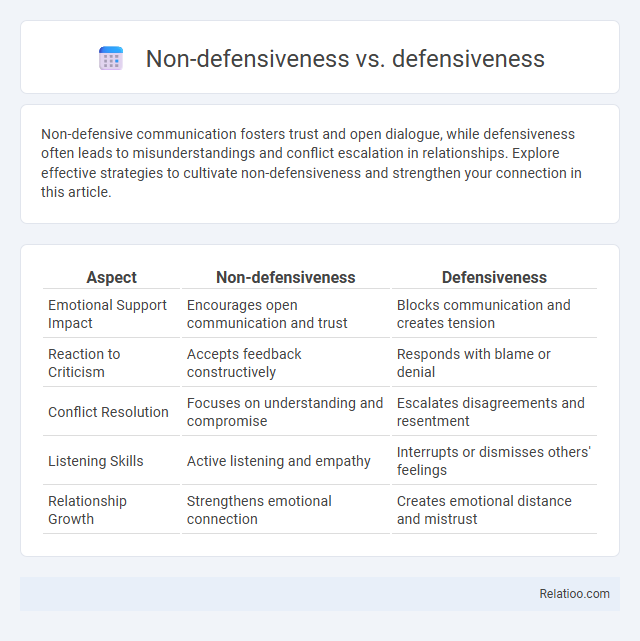Non-defensive communication fosters trust and open dialogue, while defensiveness often leads to misunderstandings and conflict escalation in relationships. Explore effective strategies to cultivate non-defensiveness and strengthen your connection in this article.
Table of Comparison
| Aspect | Non-defensiveness | Defensiveness |
|---|---|---|
| Emotional Support Impact | Encourages open communication and trust | Blocks communication and creates tension |
| Reaction to Criticism | Accepts feedback constructively | Responds with blame or denial |
| Conflict Resolution | Focuses on understanding and compromise | Escalates disagreements and resentment |
| Listening Skills | Active listening and empathy | Interrupts or dismisses others' feelings |
| Relationship Growth | Strengthens emotional connection | Creates emotional distance and mistrust |
Understanding Defensiveness and Non-Defensiveness
Understanding defensiveness involves recognizing behaviors such as denial, blame-shifting, or withdrawal as protective responses to perceived criticism or threats. Non-defensiveness, by contrast, promotes open communication, active listening, and self-reflection, enabling you to engage constructively without escalating conflict. Cultivating non-defensiveness improves relationships by fostering empathy and reducing misunderstandings in personal and professional interactions.
The Psychology Behind Defensive Reactions
Defensive reactions stem from the brain's instinct to protect self-esteem and identity when perceived threats or criticism arise, activating the amygdala and triggering fight-or-flight responses. Non-defensiveness involves psychological resilience and emotional regulation, allowing individuals to process feedback objectively without feeling personally attacked. Understanding these mechanisms highlights the role of self-awareness and cognitive reframing in reducing defensive behaviors to foster healthier communication and interpersonal relationships.
Common Signs of Defensiveness
Common signs of defensiveness include interrupting others, denying responsibility, and shifting blame, which hinder effective communication and problem-solving. Defensiveness often manifests as closed body language, such as crossed arms or avoiding eye contact, signaling resistance to feedback. In contrast, non-defensiveness promotes active listening, open posture, and acknowledging different perspectives to foster collaboration and mutual understanding.
Characteristics of Non-Defensive Communication
Non-defensive communication is characterized by openness, active listening, and a willingness to accept feedback without feeling threatened. This style promotes clarity, mutual respect, and emotional regulation, allowing Your interactions to remain constructive and focused on problem-solving. Embracing non-defensiveness helps reduce misunderstandings and enhances collaborative relationships by fostering trust and empathy.
Impacts of Defensiveness on Relationships
Defensiveness in communication often leads to misunderstandings, increased conflicts, and emotional distance, negatively impacting the quality of relationships. Non-defensiveness fosters open dialogue, empathy, and trust, enabling healthier connections by allowing you to listen and respond constructively. Maintaining non-defensiveness enhances mutual respect and collaboration, reducing tension and promoting long-term relationship satisfaction.
Benefits of Practicing Non-Defensiveness
Practicing non-defensiveness enhances communication by fostering openness and reducing misunderstandings, which leads to stronger interpersonal relationships. It encourages active listening and empathy, allowing individuals to respond thoughtfully rather than react impulsively. Non-defensive behavior promotes emotional resilience and personal growth by creating a safe space for constructive feedback and collaboration.
Root Causes: Why Do People Become Defensive?
People become defensive due to perceived threats to their self-esteem, identity, or values, often stemming from fear of criticism or rejection. Root causes include past experiences with judgment, low self-confidence, and a need for control or validation. Non-defensiveness arises when individuals feel secure, open to feedback, and confident in their self-worth, reducing the impulse to protect themselves from perceived attacks.
Strategies to Overcome Defensiveness
Non-defensiveness involves responding to criticism or feedback with openness and calm, fostering constructive communication, while defensiveness triggers resistance and conflict. Strategies to overcome defensiveness include active listening, practicing empathy, and maintaining self-awareness to regulate emotional reactions. Techniques such as pausing before responding and reframing criticism as opportunities for growth enhance emotional intelligence and promote non-defensive interactions.
Building a Non-Defensive Mindset
Building a non-defensive mindset involves recognizing triggers that provoke defensiveness and consciously choosing to respond with openness and curiosity. Embracing vulnerability and practicing active listening support emotional regulation, reducing defensive reactions in challenging conversations. Cultivating self-awareness and empathy fosters resilience, leading to improved communication and stronger relationships.
Cultivating Healthy Dialogue Through Non-Defensive Behaviors
Non-defensiveness involves actively listening and responding with openness, which fosters trust and understanding in conversations. Defensiveness, characterized by minimizing issues or blaming others, often escalates conflict and hinders resolution. Cultivating healthy dialogue through non-defensive behaviors empowers you to navigate disagreements constructively, promoting empathy and collaborative problem-solving.

Infographic: Non-defensiveness vs Defensiveness
 relatioo.com
relatioo.com